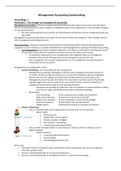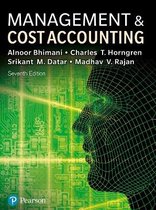Management Accounting Samenvatting
Hoorcollege 1
Hoofdstuk 1: The manager and management accounting
Management accounting = measures, analyses and reports financial information and non-financial information
that are intended primarily to assist managers in fulfilling the goals of the organisation. It also motivates managers
to make good decisions.
Een juiste beslissing binnen een bedrijf is een beslissing die overeenkomt met de strategische doelen van
dat bedrijf.
Management accounting information and reports do not have to follow set principles or rules. Strategy concerns
affect management accounting processes.
Cost accounting = measures and reports financial and non-financial information related to the organisation’s
acquisition or use of resources. It provides information for both management accounting and financial accounting.
Cost management = the actions managers undertake in the short-run and long-run planning and control
of costs that increase value for customers and lower the costs of products and services.
o An important component of cost management is the recognition that prior management
decisions often commit the organisation to be subsequent incurrence of costs.
o Cost management also includes making decisions to incur additional costs with the goal of
enhancing revenues and profits.
Management accounting heeft 2 rollen:
1. Decision facilitating: cost accounting and cost management.
o Management accounting is belangrijk om de link tussen strategie en financiële controle te
versterken MA kan expertise inzetten om scenario’s of strategische opties te vergelijken.
o Business owners and managers are faced with countless decisions every business day.
Management accounting uses information from operations to produce reports that provide
ongoing insight into business performance, such as profit margin and labor utilization, so
managers have data-driven input to make everyday decisions.
- Businesses can leverage this powerful trove of calculations to improve decision-making
over time for higher profitability and greater competitive advantage.
o Bijvoorbeeld:
- Cost Accounting job costing, process costing, cost allocations.
- Make or buy decisions outsource or do we do it yourself?
- Relevant cost decisions new investment or stick to old technology?
- Break-even analyses what should I sell to make money?
- Budget reports balanced scorecards to see where we improve.
2. Decision influencing
o How to motivate people in the organization to provide effort for the principal?
- Moral hazard
Bonus pay-outs.
Targets after contract signed.
Variance analyses – budgets.
Non-financial – monitoring.
Coordinating among departments.
o How to attract the right workers to my company to make sure they are willing to work?
(agent=manager)
- Adverse selection
Screening/referral/observation.
Ex-ante targets.
Interviewing/personality tests.
MA in actie:
1. Planning decide on company’s goals, decide how to attain these goals, plan resource usage and
allocation, predict results.
2. Decision making (facilitating) cost accounting decisions.
3. Decision control (influencing) management control – evaluation towards goals.
,Financial accounting = focuses on external reporting that is directed by authoritative guidelines. Organisations are
required to follow these guidelines in their financial reports to outside parties.
Financial accounting is guided by prescribed accounting standards.
While the work of management accountants and financial accountants tends to be organisation-specific, some
broad differences generally exist:
- Regulations
o Management accounting reports are generally prepared for internal use and no external
regulation govern their preparation.
o Financial accounting reports are generally required to be prepared according to accounting
regulations and guidelines imposed by law and the accounting profession.
- Range and detail of information
o Management accounting reports may encompass financial, non-financial and qualitative
information which may be very detailed or highly aggregated.
o Financial accounting is usually broad-based, lacking detail and intended to provide an overview
of the position and performance of an organisation over a time period.
It tends to focus on financial information.
- Reporting interval
o Management accounting reports may be produced frequently on an hourly, daily or weekly
basis, possibly to span several years.
The interval covered by management accounting information will be dictated by the
decision-making and control needs of the information users.
o Financial accounting reports are produced annually. Some large companies also produce semi-
annual and quarterly reports.
- Time period
o Management accounting reports may include historical and current information, but also often
provide information on expected future performance and activities.
o Financial accounting reports provide information on the performance and position of an
organisation for the past period.
They tend to be backward-looking.
Accounting systems are intended to provide information for 5 broad purposes:
- Formulating overall strategies and long-range plans.
- Resource allocation decisions such as product and customer emphasis.
- Cost planning and cost control.
- Performance measurement.
- Meeting external regulatory and legal reporting obligations.
Hoofdstuk 20: Strategy, the balanced scorecard and quality
Strategic management accounting = a form of management accounting which places emphasis on information
which relates to factors external to the firm, as well as non-financial information and internally generated
information.
It is orientated towards the future and the enterprise’s position relative to that of its competitors.
SMA places particular emphasis on blending external with internal organisational information. SMA
encompasses both financial and non-financial information.
,In formulating its strategy, an organisation would want to assess the industry in which it operates. This is often
performed through the lens of Porter’s 5 forces:
1. Competitors.
2. Potential entrants into the market.
3. Equivalent products.
4. Bargaining power of customers.
5. Bargaining power of input suppliers.
Two formal strategies organisations pursue are product differentiation and cost leadership.
- Product differentiation = offering products and services that are perceived by customers as being
superior and unique relative to those of its competitors.
- Cost leadership = the pursuit of low costs relative to those of competitors.
o This can be done through productivity and efficiency improvements, elimination of waste, and
tight cost control.
Balanced scorecard = translates an organisation’s mission and strategy into a comprehensive set of performance
measures that provides the framework for implementing its strategy.
It does not focus solely on achieving financial objectives it also highlights the non-financial objectives
that an organisation must achieve in order to meet its financial objectives.
The balanced scorecard measures an organisation’s performance form 4 key perspectives:
1. Financial
a. This perspective evaluates the profitability of the strategy.
2. Customer
a. This perspective identifies the targeted market segments and measures the company’s success
in these segments.
3. Internal business process
a. This perspective focuses on internal operations that further both the customer perspective by
creating value for customers and the financial perspective by increasing shareholder wealth.
b. The internal business process perspective compromises 3 principal subprocesses:
i. The innovation process = creating products, services and processes that will meet the
needs of customers.
ii. The operations process = producing and delivering existing products and services to
customers.
iii. After-sales service = providing service and support to the customer after the sale or
delivery of a product or service.
4. Learning and growth
a. This perspective identifies the capabilities in which the organisation must excel in order to
achieve superior internal processes that create value for customers and shareholders.
A company’s strategy influences the measures used in each of these perspectives.
Managers can use non-financial quality measures, these include customer satisfaction measures such as:
- The number of customer complaints and the percentage of defective units shipped to customers.
- Internal business-process measures such as the percentage of defective and reworked products.
- Learning and growth measures such as the percentage of employees trained in and empowered to use
quality principles.
Hoorcollege 2
Hoofdstuk 14: Motivation, budgets and responsibility accounting
Organisational structure = an arrangement of lines of responsibility within the entity.
Each manager, regardless of level, is in charge of a responsibility centre.
Responsibility centre = a part, segment or subunit of an organisation whose manager is accountable for a
specified set of activities.
o The higher the manager’s level, the broader the responsibility centre he or she manages and,
generally, the larger the number of subordinates who report to him or her.
Responsibility accounting = a system that measures the plans (by budgets) and actions (by actual results)
of each responsibility centre.
, Dit speelt vooral in gedecentraliseerde organisaties onder de headquarters bestaan verschillende business
units/departementen, die elk hun eigen verantwoordelijkheid hebben. Het is dan belangrijk dat elke manager van
de departementen duidelijk weet welke verantwoordelijkheid ze hebben binnen een organisatie.
4 major types of responsibility centre:
1. Cost centre = manager accountable for costs only (bv.: hoe lager de kosten, hoe hoger je bonus).
a. Cost centres zijn bijvoorbeeld optimaal als we denken aan onderhoud/IT support
(schoonmaakdiensten). Dus eigenlijk allerlei ondersteunende diensten, deze hebben weinig
invloed op het realiseren van verkopen, maar ze zijn wel belangrijk.
2. Revenue centre = manager accountable for revenues only.
a. Heeft vaker te maken met verkoop/marketing.
3. Profit centre = manager accountable for revenues and costs.
4. Investment centre = manager accountable for investment, revenues and costs.
a. Worden typisch gelinkt met de headquarters, dus bijvoorbeeld niet de Starbucks in Tilburg,
maar de Starbucks Netherlands.
The choice of responsibility centres is based on the controllability principle.
Controllability = the degree of influence that a specific manager has over costs, revenues or other items in
question.
It keeps managers/employees accountable for the items they can control. Deze verantwoordelijkheid
kunnen we inzetten om uitleg te vragen waarom een persoon bepaalde targets niet heeft gehaald (not:
who can we blame for deviations from targets?).
Hoofdstuk 2: An introduction to cost terms and purposes
Cost = a resource sacrificed or forgone to achieve a specific objective.
Usually expressed in monetary terms (euros, pounds or yen).
Goal find out the true costs. This is crucial for decision making or to motivate people to make
decisions.
Opportunity cost = the cost of giving up an alternative (bv.: je kiest om volledig één product te produceren, je
verliest dan de winst die je zou maken mocht je een ander product op dezelfde locatie geproduceerd hebben).
Actual cost = the cost incurred (a historical or past cost).
Budgeted cost = a predicted or forecasted cost (a future cost).
Cost object = anything for which a separate measurement of costs is desired to guide their decisions, managers
often want to know how much a certain thing (such as a new product, a machine, a service or a process) costs.
Examples:
- Products or product lines.
- Departments or business unit.
- Projects or programs. It depends on individual situation or interest.
- Service.
- Activity or process.
- Customers.
Cost = ∑ monetary values of all resources needed to achieve the cost object complex.
A costing system typically accounts for costs in 2 basic stages:
1. It accumulates costs by some ‘natural’ classification such as materials, labour, fuel, advertising or
shipping.
2. It assigns these costs to cost objects.
Cost accumulation (stage 1) = the collection of cost data in some organised way through an accounting system.
Cost assignment (stage 2) = a general term that encompasses both (1) tracing accumulated costs to a cost object,
and (2) allocating accumulated costs to a cost object.
Costs that are traced to a cost object are direct costs, and costs that are allocated to a cost object are
indirect costs.
Whether a cost is indirect or direct, depends on the cost object.






